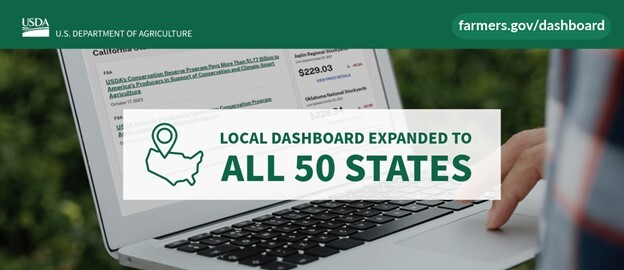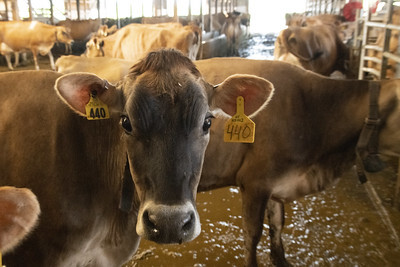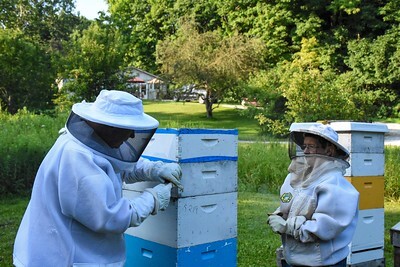
It’s April in Indiana – and this year the Hoosier state will celebrate its 208th birthday!
As a Hoosier by birth (and a Boilermaker by the grace of God), I am proud to live in our great state and am honored to serve the agricultural community every day. I know our county office employees are ready to serve you and your farms’ needs.
As the tractors begin to roar in the countryside and the first sprouts begin to appear in farm fields later in the month, please be certain to mark your calendar for later this spring to certify your crops in your local FSA office. In the meantime, if there is something you need for your operation, please reach out to your local office for assistance.
As a proud Indiana agriculturalist – like all of you – I always enjoy seeing the results of the Census of Agriculture. Just last month, the latest census numbers were published, and it so rewarding to see the high rankings of our agricultural commodities. With 53,599 farms occupying over 14.6 million acres across the state, Indiana certainly does its part to contribute to the state’s economy. Below are some facts for you to share at the local diner or with family and friends about the work we do in Indiana for American Agriculture:
- Indiana’s agricultural products are valued at over $18 billion.
- Number one producer of popcorn, gourds, and ducks.
- Number two producer of pumpkins.
- Number three producer of spearmint and turkeys.
- Number four producer of peppermint and soybeans.
- Number five producing state for corn and hogs.
- Number six producer of eggs and watermelons.
- Number ten producing state for maple syrup.
Have a safe and productive planting season!
|
 State Executive Director

On April 8, 2024, a total solar eclipse will plunge much of Indiana into momentary darkness. Excitement and interest are growing for the big event, and Hoosier communities and public safety partners are planning for the influx of hundreds of thousands of visitors to the state.
Learn more about the Total Solar Eclipse 2024 at www.in.gov/dhs/solar-eclipse-2024/. This website also includes FAQs and Resources.
Farm Service Agency Operating Status
We care about the safety of our employees and customers and have decided to close Indiana Farm Service Agency Offices within the Path of Totality on Monday, April 8th. This decision was made due to the expected influx of traffic and visitors to the area.
Additionally, staff in service centers outside of the Path of Totality have been authorized to maximize telework and therefore may not be working from the office. Please contact your local service center prior to April 8th to check availability and to schedule an alternate appointment with staff if needed.
We hope you and your families stay safe and enjoy this celestial event.
Animal Health Advisory from the Indiana Board of Animal Health
Even if you do not intend to take in the total solar eclipse (TSE) as it passes through Indiana on Monday, April 8, you might want to plan ahead if you anticipate traveling that day—especially if you are hauling livestock.
Partner agencies, including the Indiana State Police and the Indiana Department of Transportation, have advised the Indiana State Board of Animal Health of concerns about significant traffic delays associated with the scores of visitors expected to converge on Central Indiana to view the total solar eclipse at its peak.
Highways (especially I-70) and county roads in the path of the eclipse are expected to be crowded throughout the entire day and potentially long after the eclipse is finished. Crowds of TSE-watchers saw normal travel time of 2.5 hours became 9 hours after the eclipse that passed through Kentucky a few years ago.
Anyone expecting to haul livestock on April 8 should keep this in mind when planning their trips.
Also, drivers should be aware that GPS mapping systems, such as Google Maps, may direct travelers around stopped or slowed traffic. Indiana State Police is concerned with heavy trucks being routed off interstates into neighborhoods or onto roads that are impassible, contributing to further delays.
What’s more, if weather conditions are less-than-optimal in Ohio or Illinois, even more eclipse-seekers may converge on Indiana in search of a better view.
Drivers are asked to avoid pulling over or stopping on or along roadways to avoid creating hazardous driving conditions.
|
 With the recent storms that have rolled through Indiana, we want to encourage producers to report any damage to your local USDA Service Center.
FSA offers many programs to help producers recover from losses, including the Livestock Indemnity Program (LIP), the Emergency Assistance for Livestock, Honeybees, and Farm-Raised Fish Program (ELAP) and the Tree Assistance Program.
Also, the Emergency Conservation Program (ECP) may be requested for your county. Reach out to your local office to find out if this program has been requested or is approved for your county.
Producers located in counties receiving a primary or contiguous disaster designation are eligible for low-interest emergency loans to help them recover from production and physical losses.
The following programs are not listed above. Please report the damage to FSA:
In Indiana the Primary Nesting Season (PNS) for wildlife is April 1st – August 1st. What does this mean for Conservation Reserve Program (CRP) program participants?
Maintenance
Once you have established your approved CRP practice, all CRP maintenance such as mowing, burning and spraying must take place outside of the PNS for wildlife.
Should you have a maintenance issue such as weeds, insects or undesirable species that left untreated would adversely impact your approved cover, you can submit a request to your local FSA office for permission to spot treat the affected area.
When spot treatment is determined necessary, the county office will approve the method that results in the least damage to nesting wildlife and habitat. CRP participants must receive approval from the FSA County Committee prior to beginning spot treatment. The spot treatment is limited to the affected area of the field.
Management
Conservation Reserve Program (CRP) policy requires participants with certain practices to perform a management activity during the life of the contract. Mid-contract Management (MCM) activities must be completed outside of the Primary Nesting Season.
More Information
Periodic mowing and mowing for cosmetic purposes are prohibited at all times. Annual mowing of CRP acreage for generic week control is also prohibited. Occasional mowing for control of weeds, insects or pests is permissible if included in the Conservation Plan and completed outside of the primary nesting season.
For information specific to your CRP contract, contact your local USDA Service Center to review your Conservation Plan.
The Farm Service Agency (FSA) is accepting offers for specific conservation practices under the Conservation Reserve Program (CRP) Continuous Signup.
In exchange for a yearly rental payment, farmers enrolled in the program agree to remove environmentally sensitive land from agricultural production and to plant species that will improve environmental health and quality. The program’s long-term goal is to re-establish valuable land cover to improve water quality, prevent soil erosion, and reduce loss of wildlife habitat. Contracts for land enrolled in CRP are 10-15 years in length.
Under continuous CRP signup, environmentally sensitive land devoted to certain conservation practices can be enrolled in CRP at any time. Offers for continuous enrollment are not subject to competitive bidding during specific periods. Instead, they are automatically accepted provided the land and producer meet certain eligibility requirements and the enrollment levels do not exceed the statutory cap.
For more information, including a list of acceptable practices, contact your local USDA Service Center or visit fsa.usda.gov/crp.
 Access local data to assist with your farming operation including
weather forecasts and up-to-date commodity pricing.
Farmers in Indiana can now access county specific farming data and USDA resources all in one place via the new farmers.gov local dashboard. Your farmers.gov local dashboard includes farming data and USDA resources including USDA news, commodity pricing, weather forecasts, historical climate data, past storm events, USDA service center locator and additional state resources for STATE and your county The dashboard transforms complex data sets into easy-to-read charts and graphs to help you quickly find information that matters to you. Learn more at farmers.gov/dashboard.

Dairy producers have until April 29th to enroll for 2024 Dairy Margin Coverage (DMC), an important safety net program offered through the U.S. Department of Agriculture (USDA) that provides producers with price support to help offset milk and feed price differences. For those who sign up for 2024 DMC coverage, payments may begin promptly for any payments that triggered in January or February 2024.
FSA has revised the regulations for DMC to allow eligible dairy operations to make a one-time adjustment to established production history. This adjustment will be accomplished by combining previously established supplemental production history with DMC production history for those dairy operations that participated in Supplemental Dairy Margin Coverage during a prior coverage year. DMC has also been authorized through calendar year 2024. Congress passed a 2018 Farm Bill extension requiring these regulatory changes to the program.
DMC is a voluntary risk management program that offers protection to dairy producers when the difference between the all-milk price and the average feed price (the margin) falls below a certain dollar amount selected by the producer. In 2023, Dairy Margin Coverage payments triggered in 11 months including two months, June and July, where the margin fell below the catastrophic level of $4.00 per hundredweight, a first for Dairy Margin Coverage or its predecessor Margin Protection Program.
2024 DMC Coverage and Premium Fees
FSA has revised DMC regulations to extend coverage for calendar year 2024, which is retroactive to January 1, 2024, and to provide an adjustment to the production history for dairy operations with less than 5 million pounds of production. In previous years, smaller dairy operations could establish a supplemental production history and receive Supplemental Dairy Margin Coverage. For 2024, dairy producers can establish one adjusted base production history through DMC for each participating dairy operation to better reflect the operation’s current production.
For 2024 DMC enrollment, dairy operations that established supplemental production history through Supplemental Dairy Margin Coverage for coverage years 2021 through 2023, will combine the supplemental production history with established production history for one adjusted base production history.
For dairy operations enrolled in 2023 DMC under a multi-year lock-in contract, lock-in eligibility will be extended until December 31, 2024. In addition, dairy operations enrolled in multi-year lock-in contracts are eligible for the discounted DMC premium rate during the 2024 coverage year. To confirm 2024 DMC lock-in coverage or opt out in favor of an annual contract for 2024, dairy operations having lock-in contracts must enroll during the 2024 DMC enrollment period.
DMC offers different levels of coverage, even an option that is free to producers, minus a $100 administrative fee. The administrative fee is waived for dairy producers who are considered limited resource, beginning, socially disadvantaged or a military veteran. To determine the appropriate level of DMC coverage for a specific dairy operation, producers can use the online dairy decision tool.
DMC Payments
DMC payments are calculated using updated feed and premium hay costs, making the program more reflective of actual dairy producer expenses. These updated feed calculations use 100% premium alfalfa hay.
More Information
USDA also offers other risk management tools for dairy producers, including the Dairy Revenue Protection (DRP) plan that protects against a decline in milk revenue (yield and price) and the Livestock Gross Margin (LGM) plan, which provides protection against the loss of the market value of milk minus the feed costs. Both DRP and LGM livestock insurance policies are offered through the Risk Management Agency. Producers should contact their local crop insurance agent for more information.
For more information on DMC, visit the DMC webpage or contact your local USDA Service Center.
|
The National Environmental Policy Act (NEPA) requires Federal agencies to consider all potential environmental impacts for federally funded projects before the project is approved.
For all FSA programs, an environmental review must be completed before actions are approved, such as site preparation or ground disturbance. These programs include, but are not limited to, the Emergency Conservation Program (ECP), Farm Storage Facility Loan (FSFL) program and farm loans. If project implementation begins before FSA has completed an environmental review, the request will be denied. Although there are exceptions regarding the Stafford Act and emergencies, it’s important to wait until you receive written approval of your project proposal before starting any actions.
Applications cannot be approved until FSA has copies of all permits and plans. Contact your local FSA office early in your planning process to determine what level of environmental review is required for your program application so that it can be completed timely.

Emergency Assistance for Livestock, Honeybee, and Farm-Raised Fish Program (ELAP) provides emergency assistance to eligible livestock, honeybee, and farm-raised fish producers who have losses due to disease, adverse weather or other conditions, such as blizzards and wildfires, not covered by other agricultural disaster assistance programs.
Eligible losses include:
-
Livestock - grazing losses not covered under the Livestock Forage Disaster Program (LFP), loss of purchased feed and/or mechanically harvested feed due to an eligible adverse weather event, additional cost of transporting water and feed because of an eligible drought and additional cost associated with gathering livestock to treat for cattle tick fever.
-
Honeybee - loss of purchased feed due to an eligible adverse weather event, cost of additional feed purchased above normal quantities due to an eligible adverse weather condition, colony losses in excess of normal mortality due to an eligible weather event or loss condition, including CCD, and hive losses due to eligible adverse weather.
-
Farm-Raised Fish - death losses in excess of normal mortality and/or loss of purchased feed due to an eligible adverse weather event.
If you’ve suffered eligible livestock, honeybee, or farm-raised fish losses during calendar year 2024, you must file a notice of loss and an application for payment by January 30, 2025.
|

The Farm Service Agency (FSA) assists beginning farmers to finance agricultural enterprises. Under these designated farm loan programs, FSA can provide financing to eligible applicants through either direct or guaranteed loans.
FSA defines a beginning farmer as a person who:
- Has operated a farm for not more than 10 years.
- Will materially and substantially participate in the operation of the farm.
- Agrees to participate in a loan assessment, borrower training and financial management program sponsored by FSA.
- Does not own a farm in excess of 30 percent of the county’s average size farm.
For more information on FSA farm loan programs, contact your local USDA Service Center or Regional Farm Loan Office. Interested producers may also visit fsa.usda.gov or farmers.gov/loans#beginning.
|
Farm Service Agency (FSA) loans require applicants to have a satisfactory credit history. A credit report is requested for all FSA direct farm loan applicants. These reports are reviewed to verify outstanding debts, see if bills are paid timely and to determine the impact on cash flow.
Information on your credit report is strictly confidential and is used only as an aid in conducting FSA business.
Our farm loan staff will discuss options with you if you have an unfavorable credit report and will provide a copy of your report. If you dispute the accuracy of the information on the credit report, it is up to you to contact the issuing credit report company to resolve any errors or inaccuracies.
There are multiple ways to remedy an unfavorable credit score:
- Make sure to pay bills on time,
- Setting up automatic payments or automated reminders can be an effective way to remember payment due dates.
- Pay down existing debt,
- Keep your credit card balances low,
- Avoid suddenly opening or closing existing credit accounts.
FSA’s farm loan staff will guide you through the process, which may require you to reapply for a loan after improving or correcting your credit report.
For more information on FSA farm loan programs, contact your local USDA Service Center or Regional Farm Loan Office or visit fsa.usda.gov.

All federal job vacancies within USDA are posted on usajobs.gov. If interested in a career with FSA, visit usajobs.gov to establish a user profile and save a search. By saving a search, USAJOBS will email you when there are new jobs that match your search criteria.
To further promote employment opportunities, USDA is going to start sending emails that highlight select (not all) positions. To receive these notifications via email, you can subscribe to “Careers” by visiting farmers.gov/subscribe and completing the following steps:
- Select “email” as your subscription type,
- Enter your email address,
- Click “submit”,
- Select the “Careers” topic under “Connect with Us”,
- Click “submit” to verify your subscription topic choice at the bottom of the page.
|
USDA announced loan interest rates for April 2024, which were effective April 1, 2024. USDA’s FSA loans provide important access to capital to help agricultural producers start or expand their farming operation, purchase equipment and storage structures, or meet cash flow needs.
FSA also offers guaranteed loans through commercial lenders at rates set by those lenders.
Check your eligibility for FSA loans by utilizing the Farm Loan Assistance Tool. Find out which of these loans may be right for you by using our Farm Loan Discovery Tool.
Producers can explore available options on all FSA loan options at fsa.usda.gov or by contacting your local USDA Service Center.
2024 Indiana FSA Important Deadline Dates
April 1 – Nesting Season begins for Conservation Reserve Program (CRP) Practices – MCM Activities are Prohibited During Nesting Season
April 8 - Solar Eclipse - Offices Closed or Maximizing Telework
April 29 - Final Date to Enroll in the 2024 Dairy Margin Coverage Program
May 27 - Offices Closed in Observance of Memorial Day
May 31 - NAP Sales Closing Date for Nursery (Ornamental Nursery & Nonornamental Propagation Nursery) for the Crop Year June 1 - May 31
May 31 - Final Date to Obtain Loans or Loan Deficiency Payments (LDP's) on 2023 Harvested Feed Grains and Soybeans
Ongoing – Submit an Application for a Farm Storage Facility Loan
Ongoing – Submit an Offer for Continuous Conservation Reserve Program Practices
Continuous - Submit an Application for FSA Farm Loans
Continuous - Signup for Local County Office FSA Text Alerts - Text Your Service Center Keyword to FSANOW (372-669)
Continuous – Sign up for GovDelivery Newsletters, Bulletins and Indiana Press Releases (Subscribe to USDA Emails for Farmers | Farmers.gov)
|